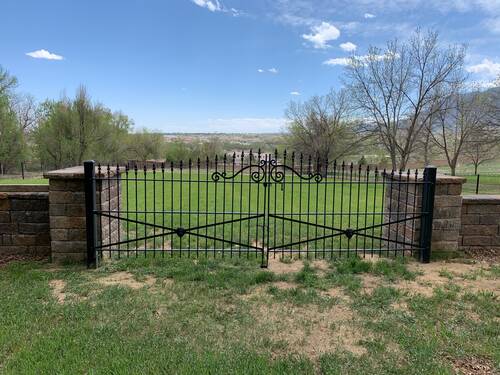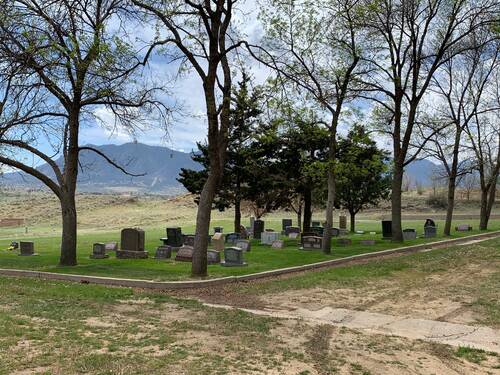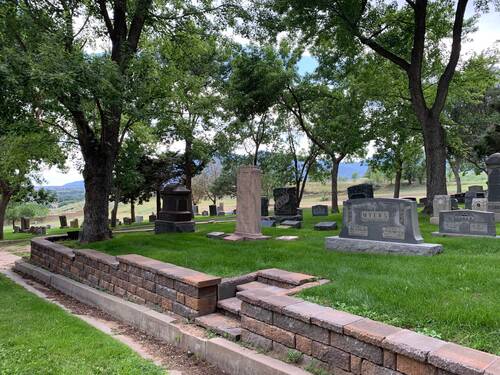Sons of Israel Cemetery
Sons of Israel Cemetery
Sons of Israel Cemetery was established in January 1903 by members of the Sons of Israel Association. The Cemetery was incorporated and dedicated as an Orthodox Jewish cemetery under the direction of its initial trustees: Isaac Cahn, Max Safron, Benjamin Rosenberg, M. Behrman and A. Wasserstrom.
In 1975, Sons of Israel Cemetery became the property of Temple Shalom. Today, Sons of Israel Cemetery remains owned and maintained by Temple Shalom and is governed by the Temple's Cemetery Committee and By-Laws. Sons of Israel Cemetery is open to all Jews (born or by conversion).
There are two section options: B'Nai Israel section (Orthodox) Established 1903 & Beit Shalom section (Non-Orthodox) Established 2020. Beit Shalom is open to all Jews (born or by conversion, and their spouses).
Sons of Israel Cemetery is located behind city-owned Evergreen Cemetery: 1005 Hancock Expy. (map below), Colorado Springs, CO 80903. Enter through the Evergreen Cemetery main gate and proceed to the southwest area--follow the Sons of Israel signs.
Jewish Burial in Colorado Springs
If you are looking to purchase a plot, please arrange to visit the Jewish cemetery by contacting the Temple Shalom office for an appointment:
1523 E. Monument Street, Colorado Springs, CO 80909 | 719-634-5311, or
Before you go to the cemetery to select a plot, think about the following:
- How many plots will you need to purchase?
- Are any of your family members not Jewish?
- Will anyone want to be cremated?
- Do you have any family/friends in Sons of Israel Cemetery (Orthodox)?
At the cemetery appointment, you will be given a packet that contains a worksheet and the rules and regulations for both sections of the Cemetery. You will have an opportunity to discuss your needs and make a plot selection. Our Committee volunteers will gladly assist you.
Plots are purchased through the Temple Shalom business office. Payment for a plot(s) must be made in full at the time of purchase. Adjacent plots cannot be reserved without full payment and purchase. Upon receipt of payment the purchaser will receive a certificate that reflects the buyer's name and location. The price of a plot is $3,600.00*.
Steps to Complete Plot Purchase
- Visit the cemeteries with a representative of the Cemetery Committee.
- Open the cemeteries packet as you walk around the cemeteries and select 3 possible burial sites.
- Circle plot selection on the worksheet that you used at the cemeteries.
- Fill out the Family Information Sheet for each plot that will be purchased.
- Person making the payment needs to read and sign the Rules and Regulation for either B'Nai Israel or Beit Shalom.
- Make payment to Temple Shalom and receive a "Paid In Full" receipt from the Temple Shalom business office. Online payments may be made via the website.
- Return completed packet and paid-in-full receipt to the Cemetery Committee Chair, and you will receive a certificate for each plot purchased to be placed with your important family documents.
* Discounted rates may apply for members in good standing. Check with the Temple Shalom office for details. Opening and closing costs are arranged directly with Evergreen Cemetery and must be paid prior to burial. Evergreen Cemetery Office is located at: 1005 Hancock Expressway, Colorado Springs, CO 80903, contact them directly at 719-385-6254 for questions or to arrange payment.
| Show |
|
Sons of Israel Cemetery Cemeteries 1005 Hancock Expy. |
Show On Map | ||
Photos - Sons of Israel Cemetery
.
Gate at Beit Shalom Section

Looking west to the Orthodox section B'Nai Israel

Sons of Israel - Block 1 (B'Nai Israel Section)
For more information on plots, locations available or a site-visit tour, please call the Temple Shalom Office and make an appointment with a member of our Cemetery Committee.
Understanding Jewish Headstones-Common Uses
Hebrew and Yiddish symbols and abbreviations you might encounter on Jewish headstones.
Abbreviations will have the caret mark or two hash marks between letters, usually before the last letter in an abbreviation.
More common symbols on Jewish headstones.
In the bible, many prominent individuals were named after animals. The practice returned with Jews in Europe, where Yiddish words for animals were used alongside Hebrew.
With names referring to animals, there is a strong opportunity for artistic interpretation in engraving. Common symbols include more than animals, though.
| Symbol | Meaning and Explanation |
|---|---|
| Lion | The lion is the symbol of the descendants of Judah. A lion might appear on the headstone of someone named Judah, Lieb, Levi, Aryeh (Herbew meaning “lion”), Loew, or Loeb. |
| Deer | It is generally thought that the name Tzvi in the bible referred to deer. The Yiddish word for deer is Hersh, so that became a popular name in the last couple of centuries. You might find the image of a deer engraved on a tombstone for someone with the name Tzvi and/or Hersh (or Hirsch). |
| Bear | The name Dov Ber — a common combination name, with Dov being Hebrew and Ber being Yiddish — is symbolized by the Bear. |
| Wolf | The wolf was the symbol of the house of Benjamin, but the symbol also represents the common Jewish names of Zev (Ze’ev) in Hebrew and Wolf (Vulf) in Yiddish and other languages. |
| Birds | Birds could have several meanings. The names Zipporah (Hebrew) and Fayge or Feige (Yiddish) are represented by birds, but birds have also indicated the freedom of souls upon death. |
| Broken tree branch or stump | These concepts symbolize the idea of a life cut short. When the deceased was a child or a young person at the time of death, you might find this symbol on the headstone. |
| Books | If you see books engraved on a headstone, you might assume the deceased was a student of the Bible. If there are five books, the deceased would have been learned in the Torah, the five books of Moses. |
| Charity box | Charitable living is an important tenet of Judaism, so families may wish to honor a deceased’s charitable nature. The symbol of a hand in a charity box may indicate that the deceased was a philanthropist or otherwise prioritized giving. |
Common Hebrew words on Jewish headstones.
| English Definition and Explanation | Hebrew |
|---|---|
| The beloved (m/f). Used to described the deceased with praise. ha-yakar, ha-y’karah | היקר / היקרה |
| Father, my father, our father. av, avi, avinu | אב / אבי / אבינו |
| Mother, my mother, our mother. im, imi, imanu | אם / אמי / אמנו |
| Brother, my brother, our brother. akh, akhi, akhinu | אח / אחי / אחינו |
| Sister, my sister, our sister. akhot, akhoti, akhot shelanu | אחות / אחותי / אחות שלנו |
| My husband. ba’ali | בעלי |
| My wife. ishti | אשתי |
| Man. ish | איש |
| Woman. ishah | אשה |
| Unmarried woman. b’tulah | בתולה |
| The Levite. ha-levi | הלוי |
| The Kohen (Cohen). ha-koheyn | הכהן |
| Year. shanat | שנת |
Understanding dates on Jewish headstones.
The letters of the Hebrew alphabet are used to represent days of the month and the year, and the name of the month on the Jewish calendar is often spelled out. Here’s the Hebrew alphabet with each letter’s numerical value, the gematria.
| Translit. | Value | Letter | Translit. | Value | Letter | |
|---|---|---|---|---|---|---|
| Alef | 1 | א | Lamed | 30 | ל | |
| Bet / Vet | 2 | ב | Mem | 40 | מ | |
| Gimel | 3 | ג | Nun | 50 | נ | |
| Dalet | 4 | ד | Samekh | 60 | ס | |
| Hay | 5 | ה | Ayin | 70 | ע | |
| Vav | 6 | ו | Pay / Fay | 80 | פ | |
| Zayin | 7 | ז | Tzade | 90 | צ | |
| Khet | 8 | ח | Kuf | 100 | ק | |
| Tet | 9 | ט | Resh | 200 | ר | |
| Yud | 10 | י | Shin / Sin | 300 | ש | |
| Kaf / Khaf | 20 | כ | Tav | 400 | ת |
Letters can be combined to form numbers. For example, י״ב would represent 12 because י is 10 and ב is 2. Years in the Jewish calendar are similarly represented by letters. The example below shows how that is calculated.
These are the months in the Jewish calendar.
| Translit. | Month | Translit. | Month |
|---|---|---|---|
| Iyar | איר / אײר | Nissan | ניסן |
| Tamuz | תמוז | Sivan | סיון / סיװן |
| Elul | אלול | Ab | אב |
| Marcheshvan / Cheshvan | מרחשון / חשון | Tishrei | תשרי |
| Tevet | טבת | Kislev | כסלו / כסליו |
| Adar I (leap year) | אדר א׳ | Shvat | שבט |
| Adar or Adar II (leap year) | אדר שני / אדר / אדר ב׳ |
Here’s how you would “decode” a date and the rest of the information on a Jewish headstone.
First line: “Here lies.”
Second line: “Rakhel, daughter of Mr. Yeshiah.”
The third line is the date. First, נפ׳ is the abbreviation for “died,” so we know we’re coming upon a date. Next is the day of the month, כ׳ג, which represents the 23rd. Next is the name of the month, חשון (Kheshvan).
The next “word” is the year in Hebrew letters, תש׳ח. Add up the values of those three letters, 400 + 300 + 8, or 708. Add 5,000, because it’s shorthand to drop the first digit in dates. It helps save space. So the date in the Jewish calendar is 23 Kheshvan 5708.
Use this Hebrew calendar date converter to determine the corresponding date on the Gregorian calendar. The result is November 6, 1947, which you can see is also engraved on the headstone. (It works!)
Sometimes, instead of a date of א׳ or the first of the month, the inscription will say ראש חדש — head of the month. The inscription may also reference holidays instead of the specific date.
Word play.
Acrostics are fairly common on Jewish headstones. Here’s an example from my own family. The first letter of each line (after “Here lies”) spells out the full name of my 2nd great grandmother, Rebecca Kashowitz Nachamin (Neckameyer): רבקה בת אברהם משה נאכאמין.
Although I’m still hoping for a translation, I understand the inscription is a poem.
Interesting reading for further knowledge about Jewish headstones, tombstones, and epitaphs.
Thu, November 20 2025
29 Cheshvan 5786
Rules and Regulations
View the
Temple Shalom Calendar
Proudly serving our community in the Reform and Conservative traditions.
1523 E. Monument Street | Colorado Springs, CO 80909 | 719-634-5311
© Temple Shalom. All rights reserved.
Privacy Settings | Privacy Policy | Member Terms
©2025 All rights reserved. Find out more about ShulCloud















